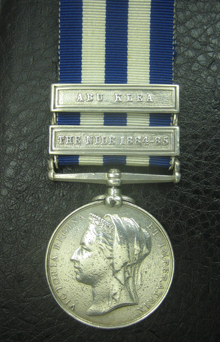
EGYPT AND SUDAN 1882, DATED REVERSE, 2 CLASPS THE NILE 1884-85, ABU KLEA ‘2004 SGT E. WELLSTEAD. 1/R. SUSS: R’
Edward Wellstead, an 18 year old labourer from Chichester, Sussex, enlisted into the Royal Sussex Regiment on 10 June 1873. He was promoted Lance Corporal in August 1878 and Corporal in May 1879, he served in Egypt from July 1882, being promoted to Sergeant in August 1882 and serving throughout the Egypt campaign of 1882 (no clasp medal). Promoted Colour Sergeant on 6 March 1883, he served in the Nile Campaign of 1884-5, taking part in the battle of Abu Klea (clasps to medal) and commanded the detachment of his regiment on the Bordein steamer during the attempt to relieve General Gordon.
Wellstead was tried by General Court Martial on 26 August 1885 and reduced to Sergeant but was re promoted Colour Sergeant 2 months later. He reverted to Sergeant (at his own request) on 9 September 1889 but was arrested, tried and reduced to Corporal on 20 June 1890. Promoted searched the following June, he was discharged in June 1894 on termination of his second period of engagement. He was not entitled to the LSGC Medal due to his misdemeanours.
At the battle of Abu Klea fought on 16 January 1885, Colour Sergeant Wellstead served with ‘C’ Company under Captain Trafford on the right side of the square. The sheer weight of the onslaught to the left-hand rear corner of the square hurled the Heavy Cavalry Detachment across into the back of the Royal Sussex, whose steady fire saved the square from annihilation. Advancing on to the Nile, 2 days later, he fought at fought at Abu Kru.
Shortly after the latter battle, two small steamers, the Bordein and the Telahawiya, arrived up the river in time to attempt a dash up to Khartoum through the cataracts before the river levels dropped too far to make this impossible. Captain Trafford of the Royal Sussex Regiment was chosen to command a small detachment of 20 men from his own company, all carefully selected by him. These chosen men were sharpshooters and all proven men, who had served well at Abu Klea and Abu Kru. 9 of the accompanied Captain Trafford in the Telahawiya and Colour Sergeant Wellstead commanded 9 men of the Company on the Bordein.
Before they set off, the Guards protested that, dressed in khaki, the Royal Sussex men were inappropriately dressed and prestige demanded that red tunics be worn! Tunics were borrowed to overcome this jealous outburst although not actually worn, and the little contingent set off on 24 January 1885.
https://www.melik.org.uk/discover/nile-gunboats/send-a-gunboat/
Reaching the sixth cataract, on the 25th, the Bordein stuck on a rock and it took into the following day before it could be dislodged and progress on up the river made, until, after a brief exchange of fire with a Mahdist fort as they passed on the morning of 28 January Khartoum came into sight. The steamers, protected with sandbags and boxes now came under a heavy fire from the bank at the village of Halfiyeh and the from Tuti island. The Sussex men were said to have made good practise with their Martini-Henrys, soon a heavy fire was being directed on the small steamers from all sides including Khartoum and the penny dropped that the town had fallen.
The Steamers now attempted to steam back down the Nile. The river level was falling, and it wasn’t long before the Telahawiya struck a rock and sank, there being just time to transfer the personnel and some of the sores onto the Bordein. The sixth Cataract and Shabluka Gorge were successfully negotiated before the Bordein suffered the same fate, striking a rock, and just managing to beach on a sand bank. All were now stranded on an island forty miles from the relative safety of the main force, in the midst of hostile country, whilst a small detachment rowed on down the Nile to seek help, as the senior NCO Sergeant Wellstead stayed as the island was made as defensible as possible. The strength of the position proved a deterrent to any direct attack, but it was a very tense time, not knowing if news of their predicament would reach the main force and a rescue attempted.
Word did get through and the Safiya, after having its boiler shot through, finally brought relief. All piled on board, and braving fire from the fort on the bank made it safely to Abu Kru on 4 February.
Several men of the small detachment were subsequently awarded the D.C.M. but not Sergeant Wellstead. However it may well be that his General Court Martial shortly after the campaign in August 1885 went against him.
The following excellent website has a narrative of Sussex Regiment in the Sudan campaign of 1885, this including transcripts from Captain Trafford’s own diary which describes the events above in detail:
https://www.royalsussex.org.uk/soldiers-stories/lionel-james-trafford/
Condition contact marks, ‘2004 S’ and ‘1/R’ on naming pretty much unreadable, Rest of naming and unit clear. Claw repined and suspender loose. Sold with a sizable quantity of research.
Despite this being a well-worn medal, this is a rare opportunity to purchase the Senior NCO of the brave little band of Sussex Men who Jan Morris described as witnessing the end of the Empire, on the sight of the Crescent flying over the walls of Khartoum.